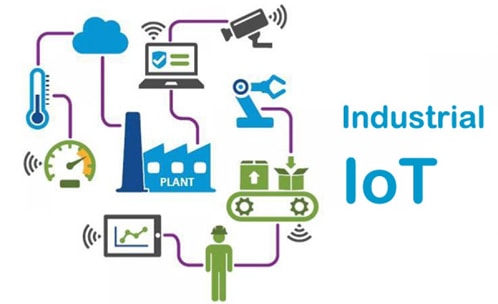Unleashing the potential of IoT by connecting the physical and digital worlds
Leave a CommentThe global manufacturers are on the cusp of a fourth Industrial revolution at present. The so-called smart manufacturing is based on the IoT (Internet of things) and understanding of the rich data that resides at the network’s edge. To realize the full potential of industrial IoT, organizations must integrate the operational technology with the enterprise IT. They may need to collect data and analyze it companywide – from the customer order and production, to supply chain as well as delivery – to generate actionable insights.

By doing so, companies can better manage the production, address any customization requirements and generate customer insights. In turn, they can manage their businesses more intelligently, improve response time, reduce costs, promote innovation and boost revenues. IIoT is best understood as a system of systems and is constituted of different elements which are dependent on end-to-end system integration. In this blog, we discuss how industrial IoT is changing the competitive landscape for manufacturers.
IIoT: Driving the new revolution
The manufacturers must merge the operating technologies and enterprise IT to optimize performance, upgrade processes and develop valuable products. The industrial IoT connects people and the physical world including the physical world of places and machines with the digital world of cloud platforms, software, augmented reality, automation, artificial intelligence, and data. IIoT enables maintaining a single view of analytical data that operates with real-time agility and responds to adverse
IIoT helps maintain a single view of analytical data, operating with real-time agility and responding to adverse events within the manufacturing plant. For this, the functional integration of various applications, infrastructure, and systems is needed. Engineers can create complex control systems to implement increasing levels of automation on the factory floor.
The foundation of integrated shop-floor systems is created by the growth in technologies built on MES (Manufacturing execution systems) and open standards. The SoC (System-on-a-chip) and MEMS (micro-electromechanical systems) allow micron-scale integration of system functionality. The high-bandwidth networks, open IP standards, and virtual hardware have basically transformed the feasibility of building IIoT platform by reducing the required cost and resources. The cloud systems provide an increasingly secure and reliable network which delivers faster results. The system can also be scaled up as needed and can integrate new apps and services which analyze data and provide valuable insights.
IIoT connects the devices to a network where they interact and exchange information. The real value of IIoT lies in the data generated from relationships between devices and their environment, data analytics, insights into efficiency, and yields. As per the latest research, by 2025- sensors and IoT will stand as pre-eminent digital technologies affecting the whole manufacturing sector. Immense potential will be created by the integrated sensor data, combined with advances in security, connectivity, analytics, and interoperability.
Technologies transforming manufacturing companies
IIoT is rooted in the physical space, unlike the traditional software applications. It integrates the data from the digital devices and systems in factories with the enterprise assets. It allows enhanced monitoring, data gathering, data integration, role-based information presentation as well as situational awareness for operators.
The integration of Internet of things, components and cloud-based analytics results enables manufacturing companies to sense and contextualize real-time data. This information can be converted into actionable insights which help maximize efficiencies across all aspects of the business. This includes design, sourcing, production, delivery, supply chain, product monitoring, etc. The objective of IIoT is to convert the data into insights. It assists in informed decision-making, drives innovation and realizes efficiencies at scale.
Data integration at enterprise, operations and customer level
IIoT is a system of systems comprised of different elements and is dependent on end-to-end system integration. It presents a long-term opportunity- integrating information across the extended organization with Operational Technologies (OTs). The OTs that drive production, transportation operations and warehouse are included. IIoT creates synergy across the organization by integrating key attributes of intelligent devices. These devices have the capability to dynamically anticipate problems, diagnose the solutions automatically and adjust operations to maintain optimum productivity.
Integration can address the stakeholder needs within the organization, across the vendor ecosystem as well as supply chain. Also, it can help customers externally by sales and service support and design feedback. This helps manufacturers gather information effectively and apply the insights obtained from networked devices to identify ways to reduce costs and increase efficiency. The systems can also be used to monetize data to enhance revenues.
The benefits of IIoT are:
- inexpensive processing
- analytics technologies which automate traditional processes
- infinite storage capacity
Multiple applications and processes work seamlessly to create a digital replica of physical assets, systems, and processes. Using this digital twin, enterprises can monitor performance remotely, and make changes in real-time to improve efficiency. Companies can upload updates, meet service needs, increase precision and quality in production and engineering. The company will get better yields, improved safety, more productive assets and lower costs.
The industrial leaders have to dynamically evolve their models while leveraging the emerging technologies to stay in the front line. They need to integrate their enterprise processes with manufacturing and engineering processes to manage every aspect of supply chain right to the customer’s doorstep.
Deriving value through IIoT
The manufacturing leaders who embrace IIoT will be better positioned to remove structural barriers which undermine technological progress. Digital integration is needed to stay ahead in the cut throat competition. This will enable you to monetize on data insights to reinvent and innovate the products quickly.
You need to align your IT and OT to create a system of systems and instrument every device in the extended manufacturing ecosystem. This will position your organization to harvest meaningful data at every touch point. You can operate processes, applications, data, devices, and assets seamlessly. This will provide your business better accuracy, cost savings, and new revenue opportunities.
Technosoft Engineering is a leader in IIoT Engineering services. Our engineers have expertise in designing and developing products that drive growth for our clients. Our world-class IIoT service is a collection of design and engineering services that help our clients from conceptualization to production of connected devices.
Engineering Initiatives to Reduce your Time-To-Market
Leave a CommentIn the current product development environment, the products as well as the technology they are based on change rapidly. It is obvious that accelerating the PDLC (Product Development Lifecycle) can produce tangible benefits to the business. It can influence all the business success measures such as:
• Revenue generation
• Early to market advantage
• Competitive advantage
• Profits and profitability
• Customer Loyalty
As most of the above-mentioned measures are critical to the success of any business so any initiative which can drive Time-To-Market will be of utmost importance.
Engineer to Order Product Development
Considerable activities before the launch of the product lie with the Research and Development and the Engineering department for most of the products. The kind of initiatives which engineering can embark on to make sure that it gets the most out of every second are:
- Standardization: The engineering processes standardization can help avoid reinventing the complete product from the scratch each time a new request is received for developing a completely engineer-to-order product. It may not be possible to standardize the entire product as that will make ETO lose its purpose. However, the engineering standardization can be done at the parts level. By process and part standardization there can be a significant reduction in the time spent on engineering information creation and management, procuring and holding, parts handling, assembly line adjustments, etc.
- Collaboration: Collaborative engineering across divisions, plants, offices or business units from different countries can reduce the need for repeated engineering. A collaborative engineering environment can accelerate innovation and help avoid redundancy in engineering efforts thus reducing the time to market to significantly lower levels.
- Engineering Agility: In case of ETO products, each delivery is a new product development. To respond to RFP (Request for Proposal) extensive engineering may be involved in comparison to other products. Agility in engineering via a lean and mean pre-bid engineering mechanism can compress the lead time for proposals. This reduces the cost of pre-bid engineering as well as enhances the chances of winning the order. The agility can have a tremendous impact on the award-to-delivery phase of the product.
Make to Order Product Development
- Modularization: To assemble MTO products considerable time is needed depending upon the complexity of the assembly mechanism. By modularizing the assemblies as well as sub-assemblies into repeatable and reusable modules the speed to market can be enhanced. Also, modularization can help in reducing engineering effort significantly by enabling the reusability of modules in future development by simply replacing the obsolete technology.
- Standardization: In MTO standardization has a similar impact as in ETO at the building or manufacturing stage. This engineering initiative can help accelerate POC and eliminate uncertainties associated with assembly, thereby reducing downtime and unplanned delays. Standardization also helps increase asset utilization and enhances throughput so drives profitability.
- Engineering Agility: The engineering agility for MTO products provide the same benefits as in ETO products. Agility can help in increasing the engineering throughput, drives utilization, and engineering profitability.
Make to Stock Products
The MTS products best perceive the benefits of reducing the time to market. The means of achieving this is maximum for MTS products. The engineering initiatives that impact the TTM are as follows:
- Collaboration
- Re-Engineering
- Modularization
- Rapid Prototyping
- Continual Improvement
- Concurrent Engineering
- First time right
In all, it is evident that engineering can have a far-reaching impact on your business when it is aimed at solving TTM challenges. A lot of business metrics can be driven by just focusing engineering efforts on compressing TTM. But it also makes one wonder why most manufacturing companies have not embarked on such initiatives already or even if they have, why have they not resulted in the benefits that they clearly seem to be capable of delivering.
This is a question that may have a lot of answers, but one clear answer is the lack of clearly defined purpose and a measure of success. Like most initiatives the key driver to completion let alone success is the definition of measures of success of that initiative. Unfortunately, the key measures of success impacted by these initiatives are business measures and are seldom associated with engineering. However, this also goes on to emphasize the fact that engineering is also not just an isolated department, but one that can truly spell success or failure for a manufacturing enterprise.
Top 4 Key Engineering trends – Technosoft Engineering
Leave a CommentTo create a better tomorrow it is essential to work in close association with industry visionaries, clients, policy makers, public as well as financial institutions. It is about utilizing our partnerships, past experiences, key assets and employees, in the optimal way. However, to do this, awareness about ecosystem, market, environment and trends that will shape our future is must.
The key trends which are influencing the future with respect to design, engineering, infrastructure and manufacturing fall under below mentioned categories:
1. Shorter Product Lifecycles
Due to rapid pace of innovation, change, volatility and preferences, we need to design world-class products utilizing newest technologies. With the expectation of quicker ROI and scarce capital, the focus will be more on ideation, concept, and designing and development phases – before the launch of the projects.
The demand on predictability and viability will also be higher than ever before. The different players in the lifecycle will either integrate or collaborate to stay significant, will need to reinvent themselves or will get consolidated.
2. Flexible Engagement Models
These days businesses are becoming increasing complex due to inter-dependency and connects between the value chains. We see our client stakeholders and policy makers discuss wider aspects at each stage of engineering project execution, financing, planning, constraints and options.
Flexible engagement model is the best engagement model looking at the current customer demands and considering their ever-changing requirements. Flexible engagement models help to strike the right balance between cost and operational efficiency. These models are geared to provide high level of transparency and control to customers. It also provides the clients flexibility to switch from one business model to another.
3. Evolution of Automation, Robotics and Artificial Intelligence in Manufacturing Industry
We are experiencing the fourth Industrial revolution now and it’s powered by advancements that include robotics, smart manufacturing using automation, and artificial intelligence (AI). By adopting AI, the organizations can keep the inventories lean and reduce manufacturing cost resulting in growth in manufacturing sector. Having said that, the manufacturing industries also have to gear up for the plants where design team, supply chain, production line, and quality control are integrated into an intelligent engine which provides actionable insights.
Automation will enable the manufacturing sector reach a level of productivity and accuracy which is beyond human capabilities. Robots are already being used in the manufacturing industry and can even work in environments which are otherwise complicated, dangerous and tedious for humans. The robotics in future can be used to re-create the complex human tasks by using advanced voice and image recognition capabilities. The shift to smart manufacturing results in increased output, corrective action and defect detection making the entire production cycle way more efficient.

4. Importance of Knowledge and Technology
Our workplaces are expected to change and are trending towards global rebalancing amidst the digital technologies and internet facilitating the collaboration of various teams. There has been a shift in employee demographics in every organization across the globe. The diversity is reshaping the environment and the work culture. The age old system of organization structure and hierarchies are being redefined.
The key assets of any business are not just the tangible components like assets & employees but also the knowledge and how organizations manage their intangible assets. The intangible assets include especially the technical knowhow and experience of a company in executing and delivering exciting work. Training and propensity to learn will stay in focus and utilization of tools to learn, train, change, manage knowledge and mentor will be an essential component of any growth or sustenance strategy.
Why Technosoft Engineering
Technosoft Engineering leverages over 20 years of cumulative knowledge and experience to help the world’s foremost manufacturers to create top-notch products and to select, deploy and adopt the technologies which underpin the entire product realization lifecycle.
We provide flexible engagement models to enable significant cost savings to our clients that are personalized to their business requirements. We drive innovation and efficiencies drawing on a combination of people, technology and process to meet the design, production and engineering challenges faced by our clients.
We offer solutions to cover end-to-end product value chain from idea to conceptualization through designing and product development. We optimize the product launching time and make sure the project is delivered on-time.


